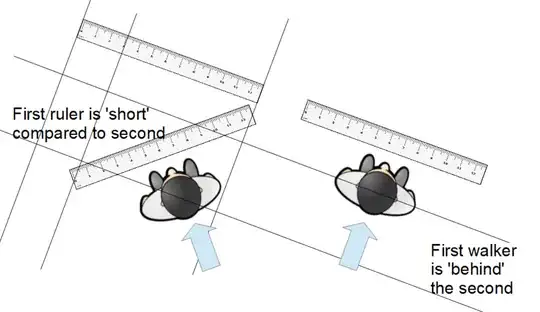The easiest way to understand time dilation and length contraction is to examine the same effects in ordinary Euclidean geometry. The analogy is not exact, but it gives the intuition a starting point that can be adjusted with the mathematical details.
Consider two people walking at the same speed but in slightly different directions across a field. Each of them defines their own coordinate system consisting of 'forwards' and 'sideways' directions. Because they are moving forwards at a constant rate, this stands in as a proxy for time. 'Sideways' then stands in for the spatial dimensions.

We look at the forwards-sideways coordinate system of the walker on the right. He lays a ruler sideways to measure space, and counts steps forwards to measure ticks of time. He glances at his companion to the left. His companion has his own ruler, laid out 'sideways', but his 'sideways' is tilted! The result is that the distance between the ends of his neighbour's ruler according to his own coordinate system is shorter than it should be. Likewise, his companion has fallen slightly behind. He appears to be moving more slowly across the field, the 'ticks' of his footsteps are closer together than they should be.
The walker on the left, looking at his companion on the right, says exactly the same things. The ends of his friend's ruler are too close together in the 'sideways' direction. He is moving 'forwards' at a slower rate. They can both see the other as shrunk in space and falling backward in time because they are each using different definitions for sideways/forwards corresponding to space/time.
The moving clock does not 'tick slower' - it is because its ticks are being measured along a different direction in spacetime. The ticks themselves haven't changed - what has changed is our choice of definitions of time and space.
The two different meanings of time in special relativity correspond to the two different meanings of 'distance' in Euclidean geometry. Say we move along some curvy winding path to the point 3 miles east and 4 miles north of where we started. How far have we walked? Well, if we just look at the distance north we have travelled, this is 4 miles. This is like the coordinate time. We have to specify a particular coordinate system, and every point has a well-defined distance from the starting point. But if we switch to a different coordinate system (magnetic north instead of true north, say) then the answer will change. The other way to look at it is the length of the curvy path we actually walked along. This corresponds to the proper time, and is the time a moving observer will experience, and is the time shown by a clock he carries with him (counting steps). The 'proper time' length for a path is the same in any coordinate system. It doesn't matter if you use magnetic north or true north or north-east and south-west as your coordinate directions - if you walked 7 miles in one coordinate system, it's 7 miles in all of them. However, there is no longer a well-defined 'distance' between points - it depends what route you took. So I might have walked 7 miles, but my twin brother walked a different route and has travelled 8 miles, although we both ended up at exactly the same place.
Coordinate time is a property of places, proper time is a property of paths.
So the reason clocks physically get out of sync is that they are measuring the along-the-curve length of the path through spacetime, and people following different routes through spacetime will travel different distances. Clocks don't measure coordinate time (unless they move in a straight line along the coordinate axis), they measure proper time.
The analogy works quite well for a lot of purposes, but there is a big difference between Euclidean geometry and Minkowski geometry, which boils down to the form of Pythagoras's Theorem. In Euclidean space, the squared length of the hypotenuse of a right-angled triangle is the sum of the squared lengths of the sides. In 3D, this looks like $h^2=x^2+y^2+z^2$. We can rotate our $xyz$ coordinates any way we like, the length remains the same. When we add a time coordinate (coordinate time, not proper time), the sign flips. So we can define a length $h^2=t^2-x^2-y^2-z^2$ which is the proper time along the straight path between two points, or we can take the other convention and define $h^2=-t^2+x^2+y^2+z^2$ which is the proper length as measured by a ruler in relativity. Either way, the length remains the same in any orthonormal coordinate system. Apart from this sign-flip, time dilation and length contraction in Minkowski space are exactly analogous to the mixing of forwards/sideways directions in Euclidean space described above. They work the same way.
Thus, clocks getting out of sync is physically no stranger than people taking different routes to the same place walking different distances along the way. The time you experience is measured along the path you follow.
